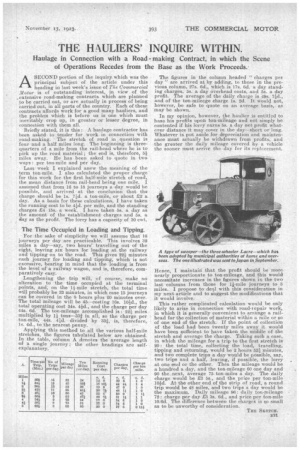THE HAULIERS' INQUIRE WITHIN.
Page 23

If you've noticed an error in this article please click here to report it so we can fix it.
Haulage in Connection with a Road making Contract, in which the Scene of Operations Recedes from the Base as the Work Proceeds;
ASECOND portion of the inquiry. which was the principal subject of the article under this heading in last week's issue of The Commercial Motor is of outstanding interest, in view of the .extensive road-making contracts which are planned to be carried out, or are actually in process of being Carrieci.out, in all parts of the country. Each of these .contracts affords work for a good many hauliers, and the problem which is before us is one which must inevitably crop up, in greater or lesser degree, in connection with them all.
Briefly stated, it is this : A haulage contractor has been asked to tender for work in connection with road-making. The stretch of road in question is four and a half miles long. The beginning is threequarters of a mile from the rail-head where he is to pick up the road material; the end is, therefore, 54 miles away. He has been asked to quote in two ways : per ton-mile and per day. .
Last week I explained anew the meaning of the term ton-mile. I also calculated the proper charge for this work for the first half-mile stretch of road, the mean distance from rail-head being one mile. I assumed that from 16 to is journeys a day would be possible, and arrived at the conclusion that the charge should be ls. 714.1. a ton-mile, or about 22 a day. As a basis for these calculations, I have taken the running cost to be, 41-d. per mile, and the standing charges ..E4 15s. a week: I have taken 5s. a day as the amount of the establishment charges and 5s, a day as the profit. The lorry has a capacity of 30 cwt.
The Time Occupied in. Loading and Tipping.
For the sake of simplicity we will assume that 16 journeys per day are practicable. This involves 32 miles a day—say, two hours' travelling out of the eight, leaving Six hours for loading at the railway and tipping on to the road. This gives 221 minutes each journey for loading and tipping, which is not excessive, bearing in mind that the loading is from the level of a railway wagon, and is, therefore, com paratively easy. •
Lengthening the trip. will, of course, make no alteration to the time occupied at the terminal points, and; on the lfrinila stretch, the total time mill probably be 33 minutes, in which case 15 journeys can be covered in the 8 hours plus 20 minutes over. The total mileage will be 45—costing 16s. 10-1d., the total operating cost 34s. 41d., and the charge per day 44s. 6d. The ton-mileage accomplished is : 221 miles multiplied by 11 tons-33i in all, so the charge per ton-mile, 44s. 41d. divided by 331, is, therefore,
is. 4d., to the nearest penny. •
Applying this method to all the various half-mile stretches, the figures tabulated below are obtained. In the table, column A denotes the average length of •a single journey : the other headings are selfexplanatory. The figures in the column headed " charges per day" are arrived at by adding, to those in the previous column, 27s. 6d., which is 17s. 6d. a day standing charges, 5s, a day overhead costs, and Os. a day profit. The average of the daily charge is 49s. 71d., and a the ton-mileage charge is. 2d. It would not, however, be safe to quote on an average basis, as may be shown, In my opinion, however, the haulier is entitled to base his profits upon ton-mileage and not simply be • contented if his lorry earns 5s. a day not profit whatever distance it may cover in the day---short or long. Whatever is put aside for depreciation and maintenance must actually be withdrawn from profits, and the greater the daily mileage covered by a vehicle the sooner must arrive the day for its replacement.
Hence, I maintain that the profit should be more nearly proportionate to ton-mileage, and this would necessitate increases in the figures shown in the two last columns from those for 1*-mile journeys to 5 miles. I propose to deal with this consideration in my next article and to suggest the modifications that it would involve.
This rather complicated calculation would be only likely to arise in connection with road-repair work, in which it is generally convenient to art ange a railhead for the collection of material within a mile or so of one end of the stretch. If the point of collection of the load had been twenty miles away it would have been sufficient to have taken the middle of the stretch and average the charge. Taking sir+ a case, in which the mileage for a trip to the first stretch is 20: the total time, collecting the load, travelling, tipping and returning, wotild be 2 hours 521 minutes, and two complete trips a day would be possible, say, two trips and a half, leaving, if possible, the lorry at one end or the other. Then the mileage would be a hundred a day, and the ton-mileage 60 one day and 90 the next, average 75 ton-miles a day. The daily charge would be 23 5s., and the price per ton-mile 10/d. At the other end of the strip of road, a round trip would be 48 miles, and two trips a day would be the maximum. Daily mileage 96: daily ton-mileage 72: charge per day £3 3s, 6d., and price per ton-mile 10.6d. The difference between the charges is so small as to be unworthy of consideration.
















































